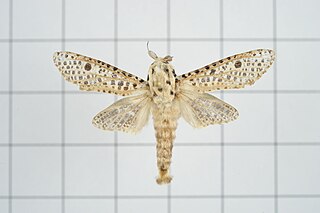Urodidae or "false burnet moths" is a family of insects in the lepidopteran order, representing its own superfamily, Urodoidea, with three genera, one of which, Wockia, occurs in Europe.
Metachanda is the sole genus in tribe Metachandini of moth subfamily Oecophorinae. Metachandini was originally described as family Metachandidae by Edward Meyrick in 1911, and at the time also contained the genus Chanystis, which is currently unplaced to tribe within Oecophorinae. It has also previously been described as tribe Metachandini of subfamily Gelechiinae.
Agathiphaga is a genus of moths in the family Agathiphagidae, known as kauri moths. This caddis fly-like lineage of primitive moths was first reported by Lionel Jack Dumbleton in 1952, as a new genus of Micropterigidae.
Hapda is a genus of moths of the Noctuidae family. It was first described by Francis Walker in 1863 as Dapha.
Argonestis is a monotypic moth genus in the family Lasiocampidae. The genus was erected by Vadim V. Zolotuhin in 1995. Its only species, Argonestis flammans, was described by George Hampson in 1893. It is found in the Indian state of Manipur.

Blepharoctenucha is a monotypic moth genus in the family Geometridae described by Warren in 1895. Its only species, Blepharoctenucha virescens, first described by Arthur Gardiner Butler in 1880, is known from India and Taiwan.
Buttia is a monotypic moth genus in the family Geometridae described by Warren in 1904. Its only species, Buttia noctuodes, was described by the same author in the same year.
Entogonia is a genus of moths in the family Geometridae described by Warren in 1904.
Hesperumia is a genus of moths in the family Geometridae. The genus was described by Packard in 1873.
Ithysia is a monotypic moth genus in the family Geometridae. Its only species is Ithysia pravata. The genus was erected by Jacob Hübner in 1825, but the species had been first described by Hübner in 1813.
Lachnocephala is a monotypic moth genus in the family Geometridae described by David Stephen Fletcher in 1953. Its only species, Lachnocephala vellosata, known from Chile, was described by the same author in the same year.
Panagropsis is a monotypic moth genus in the family Geometridae described by Warren in 1894. Its only species, Panagropsis equitaria, described by Francis Walker in 1861, is found in South Africa.
Paraboarmia is a monotypic moth genus in the family Geometridae erected by F. Krampl in 1994. Its only species, Paraboarmia viertlii, first described by Bohatsch in 1883, is found in Europe.
Polyacme is a genus of moths in the family Geometridae. The genus was described by Warren in 1896. Both species are from Australia.
Colabata marginalis is a moth in the family Bombycidae. It was described by Francis Walker in 1856. It is found in Brazil.
Carposina mediella is a moth in the Carposinidae family. It was described by Francis Walker in 1866. It is found in Australia, where it has been recorded from Tasmania, South Australia, New South Wales, Victoria, Queensland and Western Australia.
Groenendaelia is a monotypic moth genus in the family Cossidae. Its only species, Groenendaelia kinabaluensis, is found in Sundaland, including Borneo. The habitat consists of montane forests and lowland areas.
Morpheis pyracmon, the fissured bark, is a moth in the family Cossidae. It was described by Pieter Cramer in 1780. It is found in Suriname, Venezuela, Ecuador and Peru. The habitat consists of cloudforests, where it is found at altitudes between 400 and 1,200 meters.
Psychonoctua personalis is a moth in the family Cossidae. It was described by Augustus Radcliffe Grote in 1865. It is found on Cuba, Jamaica, Hispaniola and Puerto Rico.

Rapdalus pardicolor is a moth in the family Cossidae. It was described by Frederic Moore in 1879. It is found in Taiwan, India, Thailand and Laos.



